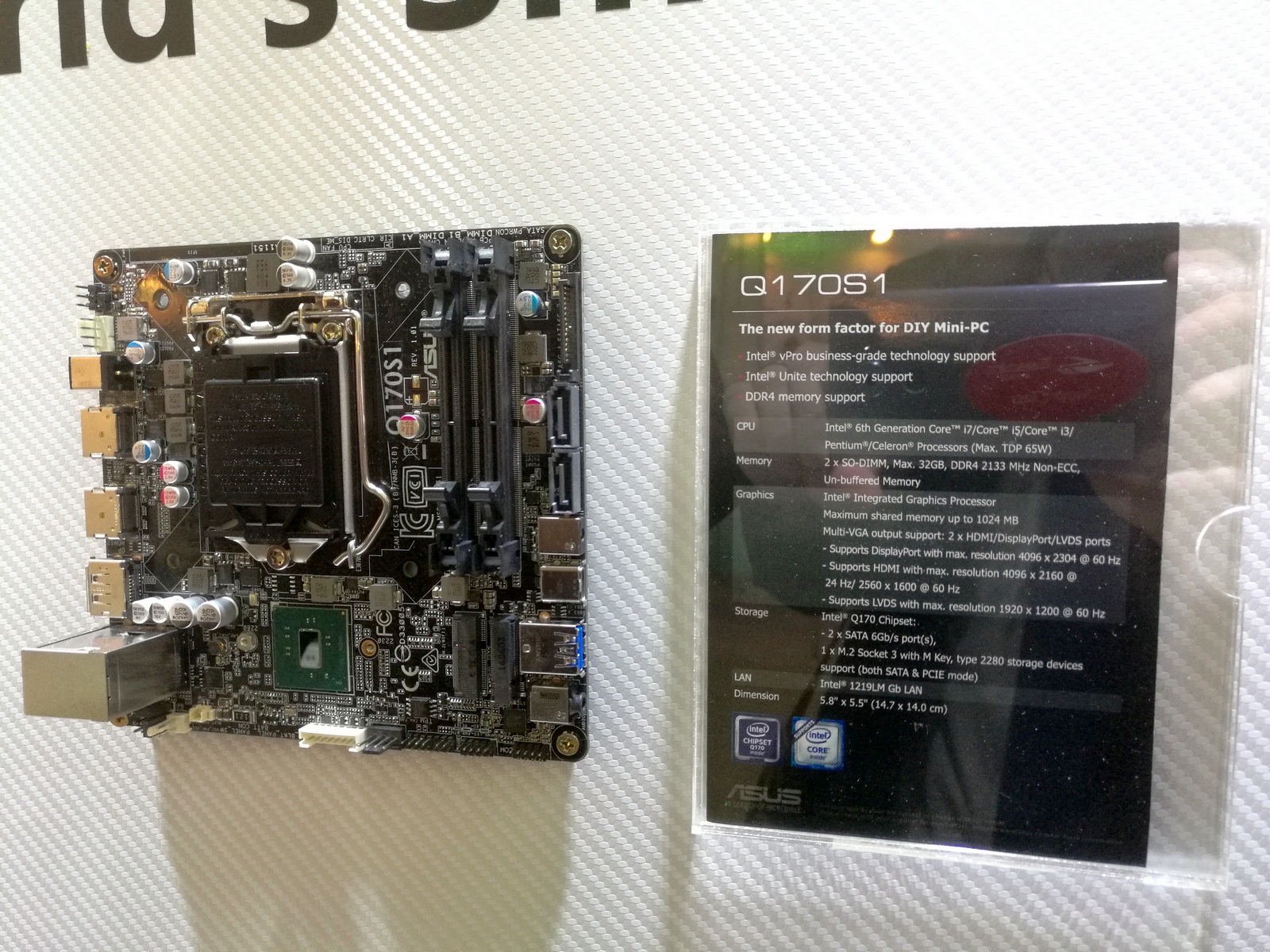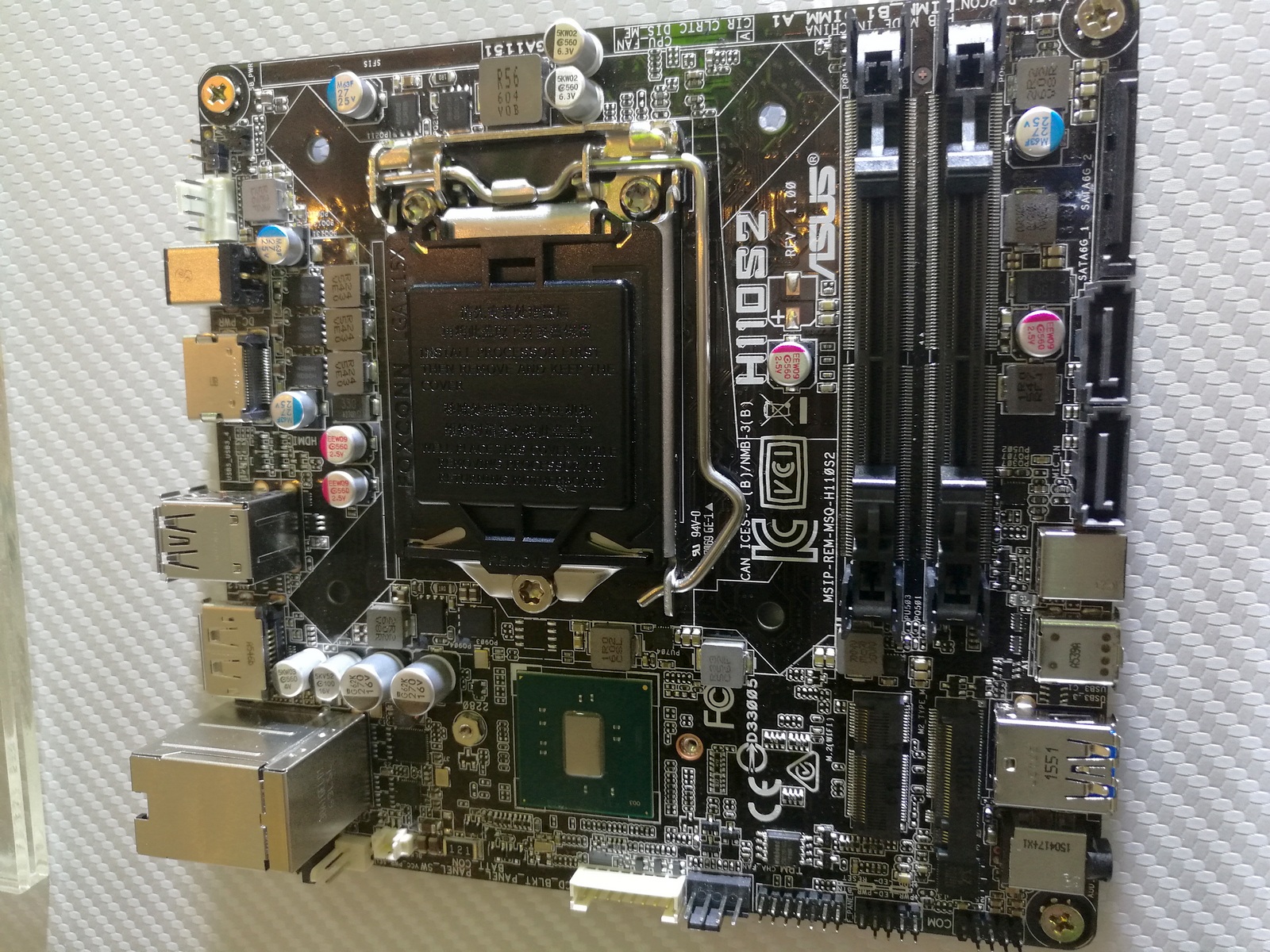ASUS at Computex 2016: The 10 Years of the Republic Of Gamers (ROG) Booth Tour
by Ian Cutress on June 22, 2016 8:00 AM ESTThe three major form factors for custom build personal computers, in order of popularity, are ATX, followed by micro-ATX and then mini-ITX. That also happens to be the order of size as well, from largest to smallest. Earlier in this piece we spoke about how motherboard design has not really changed from these three as of late, mostly due to compatibility and how everything in the industry currently works. However, at IDF in 2015, Intel announced a new form factor for mini-PCs relying purely on integrated graphics: the Mini-STX platform (also known as 5x5, for 5-inch square).
5x5
Before I left for Computex, I asked our editors want they knew would be at the show and what they would like me to cover. One of the responses from Ganesh was ‘anything Mini-STX’. We saw a couple of things at CES, although mostly pre-built mSTX systems. Luckily for Ganesh, ASUS had three motherboards on display.
The first up is the Q170S1, using the Q-series chipset for business level customers and vPro support. We haven’t typically covered the Q-series at AnandTech, however the Q170 attempts to mirror a lot of what the Z170 does but under the provision of a professional grade, managed system that doesn’t go into Xeon. This includes business level support, a separate firmware with control options, and a number of other things. There is an extra cost to the Q-series over the H-series chipsets, around $12 list price, but for the business side benefits this is usually a small price for manageability. In this case, the Q170S1 can use any Skylake processor up to 65W (up to i7-6700), two DDR4 SO-SIMM modules, and supports M.2, SATA, M.2 for WiFi, and rear panel 19V power. All graphics capabilities come from the CPU, and there’s also a vPro enabled network port to facilitate network control.
On the cheaper side of the coin are the H-series variants. These are strikingly similar in board layout, with the S2 version having dual network ports (one Intel I219-V and one Realtek 8111H) whereas the S1 version only has a single Intel I219-V. Specifications match up to the Q170S1 motherboard otherwise, with 65W processor support, but nothing vPro related.
Mini-STX is a drive for Intel towards the more industrial side of the market that wants upgradability. There are a number of platforms already in that space, such as the Intel NUC, Core-M, Atom, ECS LIVA, the MSI Cubi and others, however they are all using soldered down processors. Mini-STX enables a bit more customization within Intel’s platform structure, as well as more performance.













43 Comments
View All Comments
Ian Cutress - Thursday, June 23, 2016 - link
It's an MSword issue when you (sometimes) insert a hyperlink. Should be fixed.Soundgardener - Sunday, June 26, 2016 - link
No; it's a technical publication issue when you forego proof-readers / copyeditors. Other examples:we waited until the following day and was able to browse the ASUS ROG Booth (we WERE not we was)
and they seem willing to be prepared to pay for it (willing / prepared: pick one, delete the other ;)
Other features such as color accuracy are also lauded by the professional community as well. (also / as well: again, only one needed...)
better color reproducibility (better colour reproduction, better colour gamut, or better colour...)
alphasquadron - Wednesday, June 22, 2016 - link
For the 240hz monitor, a good way to tell if the human eye cannot tell a difference is to test it out with professional gamers (preferably fast twitch shooters). They should be able to tell you if there is a difference or do a blind test with them. I won't listen to any more regular idiots who for the previous generation said the eye cannot tell the difference between 60hz and 120hz.Lolimaster - Wednesday, June 22, 2016 - link
The main difference people should be noticing is not about "gaming" but the thing that it reduces further more the innate flaw of the LCD/OLED sample and hold way of delivering frames vs the constantly refresh nature of CRT.OLED should starting to be called true CRT successor when every panel goes at 240Hz.
alphasquadron - Wednesday, June 22, 2016 - link
Thought anything over a 100hz had a better refresh rate than CRTs, but then again not sure.Lolimaster - Wednesday, June 22, 2016 - link
Frame time (sample and hold tech):60hz 16.66ms
120hz 8.33ms
240Hz 4.16ms
Technically you'll need about 960Hz on LCD's to achieve CRT levels of smoothness (lightboost is pretty close).
alphasquadron - Wednesday, June 22, 2016 - link
That sucks because I don't see us reaching hardware to drive 960Hz anytime soon. We just got the hardware to drive 144hz at 1080p smoothly.Gastec - Wednesday, August 31, 2016 - link
Considering that LCD monitors entered "mainstream" in 2003-2004 and that good quality 144Hz+ monitors of all resolutions are still prohibitively expensive for the average Joe, I would make a quick estimate that 960 Hz and it's driving hardware would theoretically reach our mortal realms in about 160 years.Midwayman - Thursday, June 23, 2016 - link
There are studies to say that 240hz should be usable. However there are two things. Imagine persistence is more important and they didn't explicitly state ULMB support or what refresh range it works at. Second is there is really a point of diminishing returns for refresh anyways. With a 144hz monitor the difference between 60hz and 100hz is readily apparent. Going from 100 to 144hz less so. I imagine the jump to 240hz even less important.Bragabondio - Wednesday, June 22, 2016 - link
Can anybody explain me why for God's sake there millions of updated LGA 2011-v3 motherboards but only in ATX size!?! I was patiently waiting to build a new Broadwell E PC with micro ATX or even mini ITX board and there is not a single micro ATX that has all the new features of their big brother (some don't have USB 3.1 other have the M.2 in the older PCI 2 format - not much faster than the SATA 3 etc.) Even going for z170 ( can't believe I will be upgrading to 4 core CPU after 6 years of 4 core CPU - core i7 870!) and there are just a few micro ATX z170 boards with all the new features.I am not going back to gigantic ATX case - thank you very much, so I am left with the choice of either not upgrading (I gave my old PC to my mom so currently I use MS Surface pro with a dock that works well for office work not so much for gaming) , wait for ZEN, buy a laptop that supports external video card dock (laptop + dock would probably take the same space and would have zero upgradability - except for the video card) or cave up and get core i7 6700k.
So I don't understand why manufacturers don't want my money?